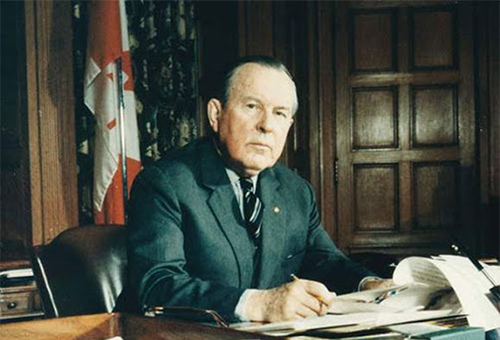
Lester B. Pearson, a recipient of the Nobel Peace Prize is a symbol of Canada’s supposed humanitarianism; In reality, however, he was a war hawk and the Godfather of Canada’s Cold War.
Part I in an exclusive CAM series on the United States’ northern neighbor and its support for the U.S. empire.
[T]here are two sides whose composition cuts across national and even community boundaries. The issues … can be described as freedom vs. slavery…. [T]wo powerful leaders of these opposed sides have emerged—the United States of America and the USSR.
We are faced now with a situation similar in some respects to that which confronted our forefathers in early colonial days when they ploughed the land with a rifle slung on the shoulder. If they stuck to the plough and left the rifle at home, they would have been easy victims for any savages lurking in the woods. (Emphasis added.)
As Canada’s Minister of External Affairs, Lester Pearson delivered the above statements in his speech entitled “Canadian Foreign Policy in a Two Power World” to a joint meeting of the Empire Club of Canada and Canadian Club of Toronto. (April 10, 1951)
For centuries, self-righteous state myths have depicted the imperial Canadian project as a victory for democracy and human rights. Despite Canada’s long record of genocide, land plunder, and war profiteering, official narratives about noble “Canadian values” still reign in this imagined “peaceable kingdom.”
Canada’s ethnonationalist propaganda demonized First Nations as hostile sub-humans to be enslaved, imprisoned on reservations and made Christian in residential schools. This White-Power racism served imperialist containment policies designed to turn “Red Indian” enemies into captive nations.

By the early 1950s, then-external affairs minister Lester Pearson was pioneering a new containment policy. During the transition to the new world order of the Cold War, he rallied his powerful allies in Canada’s racist old-boys’ clubs.
Pearson’s status as a national hero was consolidated when he won the Nobel Peace Prize in 1957 for his role in helping to establish a UN peacekeeping force.
But Pearson was far from a progressive. In 1951, he compared the new Red Menace of communism to what he called “savages lurking in the woods.” These “savages,” he declared, had violently threatened the peaceful lives of innocent white Europeans whom he lovingly called “our forefathers.”
By conjuring unsettling images of a Red-Indian bogeyman, Pearson helped manufacture consent for a new, politically Red enemy to meet the needs of NATO’s capitalist powers.
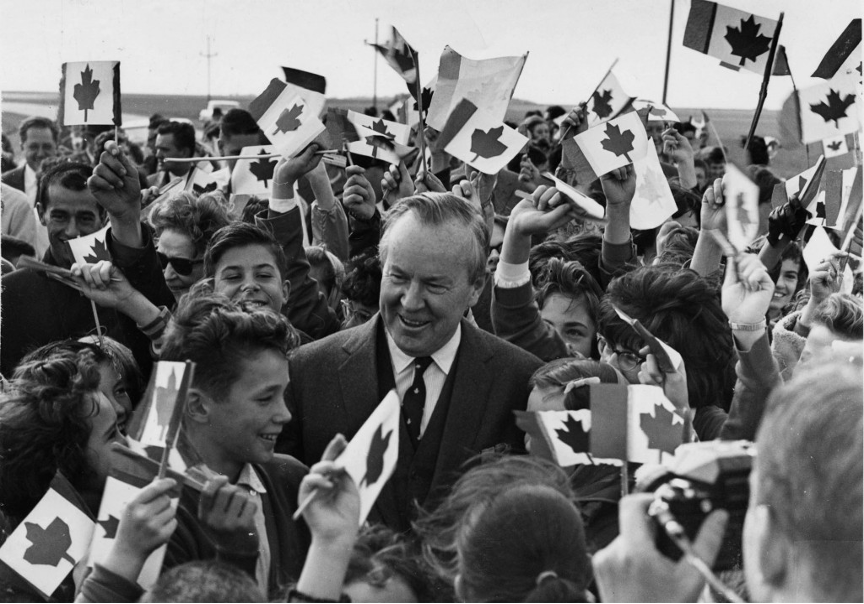
On the home front, Pearson’s fierce anticommunism justified Canada’s systematic abuses of civil rights. As Ian MacKay and Jamie Swift note in Warrior Nation: “Pearson enthusiastically supported a Cold War against any Canadians suspected of viewing the world outside the newly hegemonic framework of the American imperium.”[1]

Targeted for abuse by Canada’s Cold War elites were “peaceniks,” radical unionists and anyone branded as too leftwing. “Pearson had become an ever-more-aggressive accomplice,” said MacKay and Swift, “in government attacks on dissidents.”[2]
To Pearson and other Cold Warriors, the world was torn. As chief architect of Canada’s postwar anti-Red foreign policy, Pearson demonized the Soviet Union as the epicenter of evil. The USSR was still reeling after 27 million of its citizens had been killed by Hitler’s anti-communist crusade.
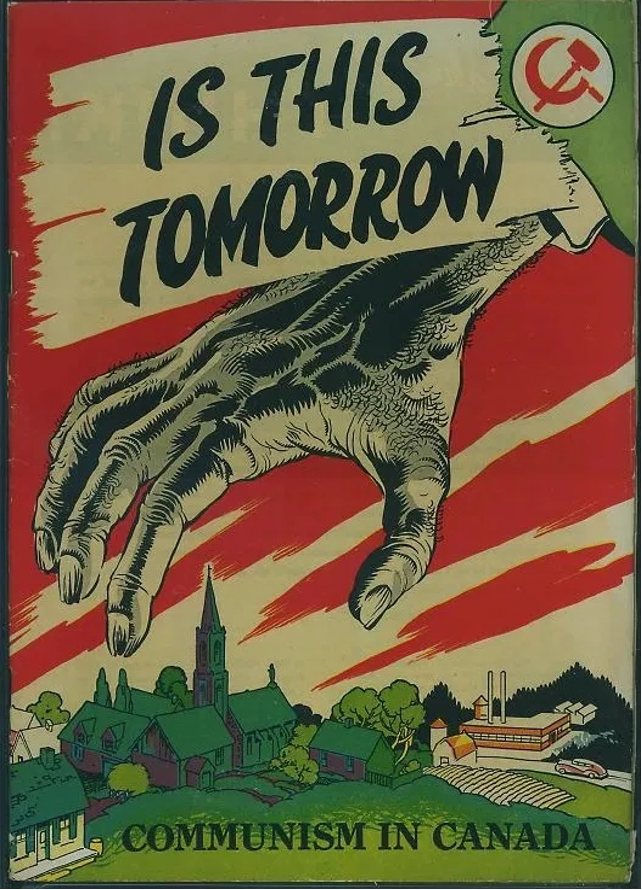
This is the cover of the Canadian edition (1947) of a U.S. comic by the Catechetical Guild Educational Society. [Source: coat.ncf.ca] 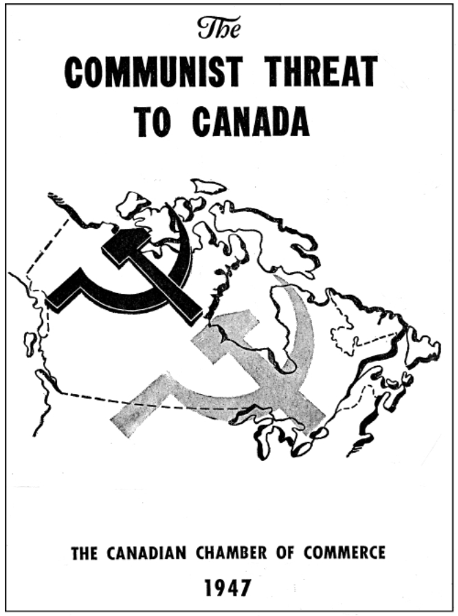
Anti-communist propaganda which Pearson echoed. [Source: coat.ncf.ca]
After the Red Army liberated Eastern Europe and led Germany’s defeat, the U.S. replaced the Nazis as global leaders in the war on communism. NATO efforts to destroy the USSR used Cold-War “containment” strategies: surrounding the Soviet Union with nuclear weapons, isolating it with political and economic sanctions, and vilifying it with propaganda. Pearson had a central role in this new phase of the West’s war on communism.
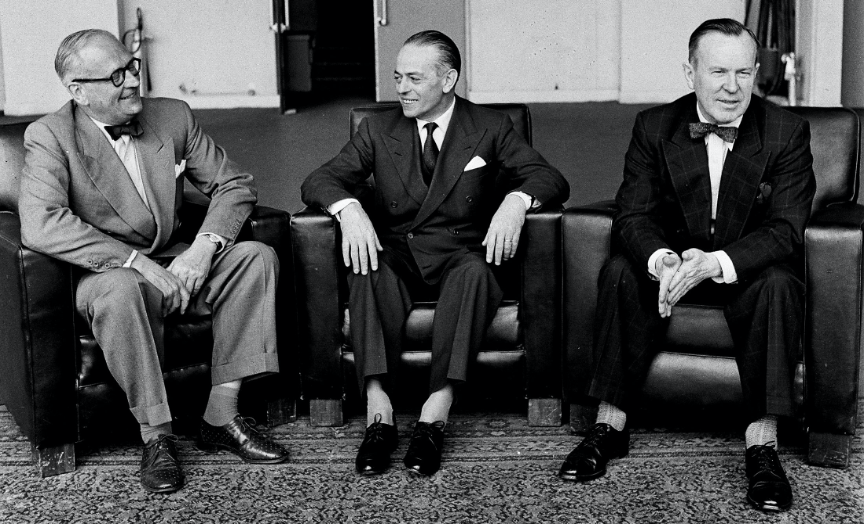
The Red Scare had been going on for decades. In Pearson’s youth during WWI and the First Red Scare (1914-20), Canada ran slave-labor, concentration camps that interned thousands of single immigrant men, mostly Ukrainians, who had been laid off from rural work camps. Elites feared their growing protests in urban centers might spark a socialist revolution.[3]
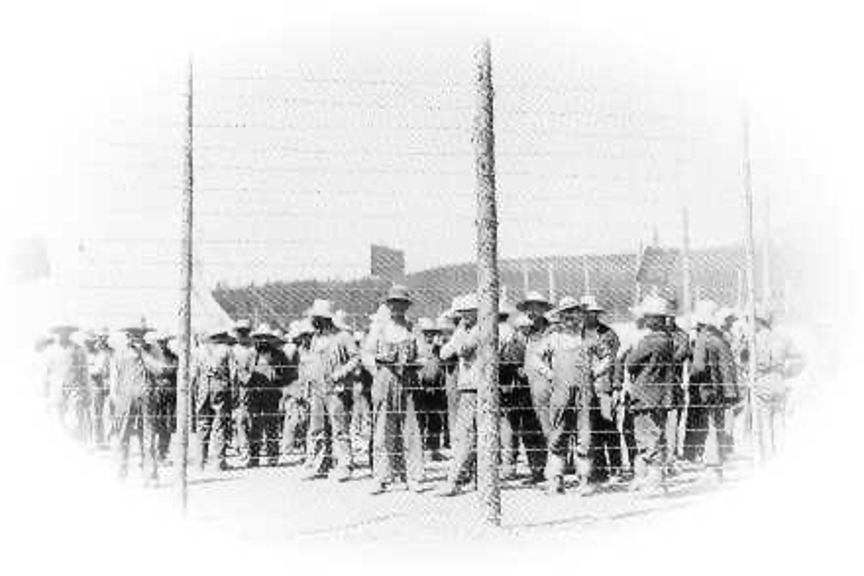
And, in 1919, Canada was among thirteen countries that invaded newborn Soviet Russia with 150,000 troops to intervene in its civil war and reverse its revolution. Canada’s allies in the war, led by Admiral Alexander Vasilevich Kolchak, killed at least 100 civilians for every one killed by the Bolshevik Red Army, according to General William S. Graves, who headed the U.S. contingent.[4]

During the Depression, when Pearson was a bureaucrat working closely with Canada’s prime minister, some 170,000 single, unemployed men were forced into remote work camps to prevent a potential revolution.[5]
One means of dismantling Canada’s prevailing peace mythology is to examine this country’s support for U.S. militarism throughout the Cold War. This study leads to the conclusion that little if anything has changed.
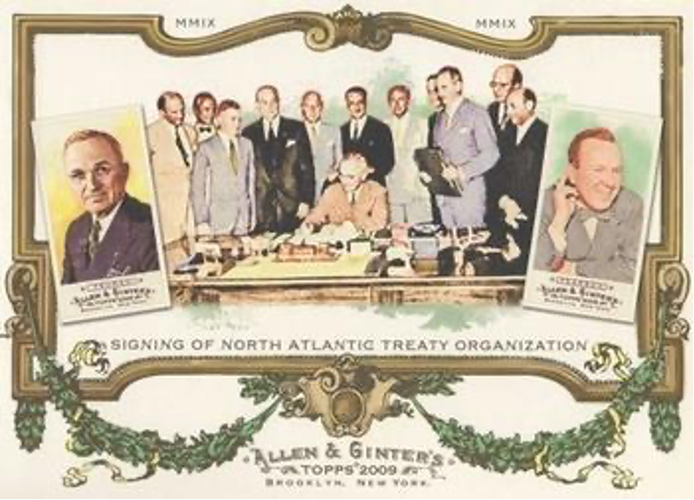
Always a stalwart NATO warrior giving solid allegiance to U.S.-led military, political, economic and propaganda warfare, Canada has taken leading roles in a new Cold War being waged by the American empire.
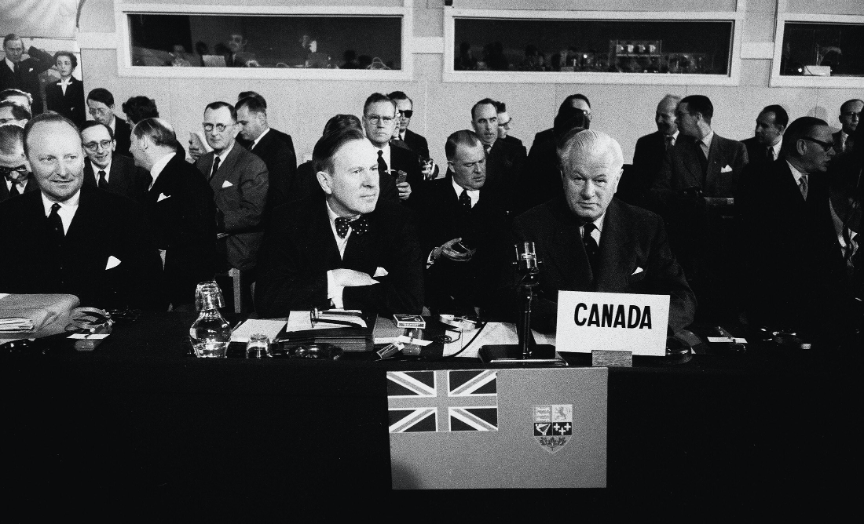
Facing Canada’s history of duplicity is especially difficult because it means challenging the villainous hypocrisy of some of this nation’s most-beloved leaders. It also means confronting the powerful, political descendants of Canada’s much-glorified peace cult heroes, and debunking pernicious narratives that are still perpetuated, even by many mainstream progressives.
Pearson As Peace-Cult Hero and Cold-War Hatemonger
While state-sponsored myths have helped to create an institutionalized cult around Pearson, Canada’s beloved Nobel Peace Prize winner was actually a vociferous Cold Warrior. Besides using hateful anti-Red rhetoric to whitewash U.S.-backed wars, Pearson rallied support for various covert actions that squashed anti-colonial struggles in Africa, Asia and Latin America.
Canada’s largest political, corporate, religious and media institutions shared with their Western allies a fierce loathing for anyone who could be labelled communist. Their global crusade maligned all individuals, groups, parties, movements and governments that dared to threaten the freewheeling reign of predatory corporations. In Lester Pearson, these fear-mongering elites found a believable voice whose skilful devotion to Cold War tropes served their shared, vested interests.
Pearson was useful to British and American power elites because he leveraged Canada’s well-crafted reputation as a neutral “middle power” to cheerlead their neocolonial adventures. This included lending Canada’s respected voice to the ousting of elected, socialist-friendly governments that tried to limit the exploits of foreign corporations.
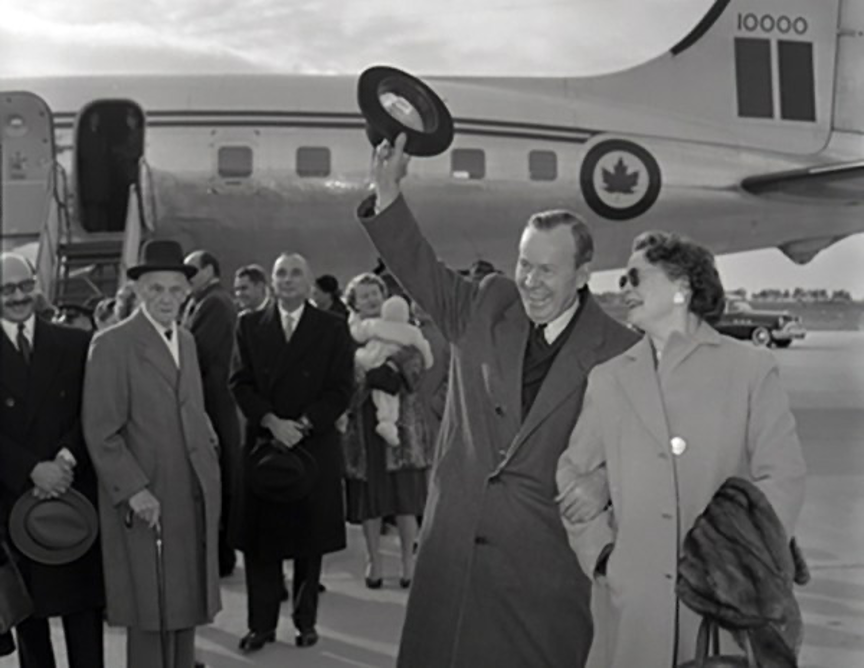
As Canada’s most influential confidence man, Pearson exuded faith in America’s supposed devotion to peace. “It is inconceivable to me that the United States would ever initiate an aggressive war,” said Pearson in 1955, and “it is also inconceivable that Canada would ever take part in such a war.”[6]
Captivated by the era’s extreme anti-communism, Pearson ignored Western war crimes. In fact, he artfully glorified these crimes with phobic narratives that painted assaults on democracy as if they were part of a noble, god-inspired plan to wipe communist evil off the face of the earth.
Before examining Pearson’s key role in leading Canada’s support for these American adventures, it is worth examining the cultural influences in his early life that helped create his pious devotion to Cold War causes.
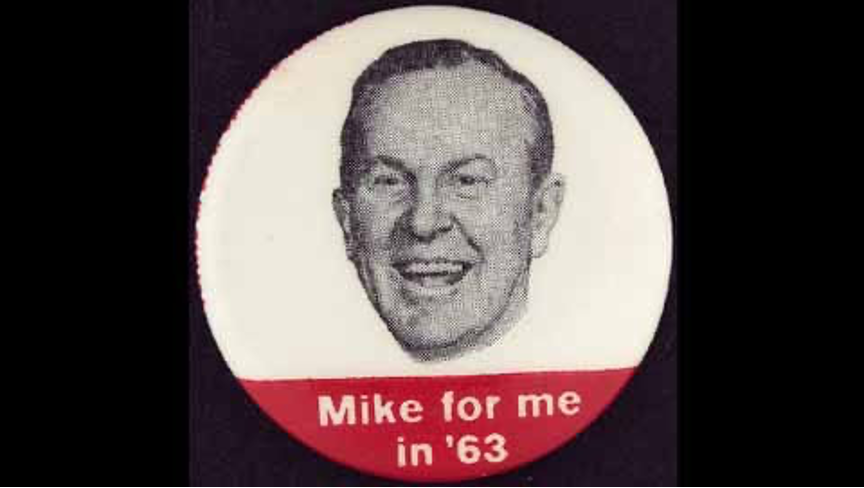
The Early Origins of Pearson’s “Muscular Christianity”
That Pearson slipped so easily into sermonizing about the Red Menace can be explained largely by his ultrareligious upbringing. His father, and both grandfathers, were Methodist ministers. [NOTE: Not sure what a “staunch” Methodist minister is.]

Methodism, which was then Canada’s largest Protestant denomination, was central to the imperial project of spreading “Christian values” at home and abroad.
This religious exercise, to build the moral muscles of a global Anglo-based civilization, fixated on the Social Gospel movement. Its mission was to take up the “white man’s burden” and uplift atheist heathens and inferior races through such genocidal institutions as Indian Residential Schools.[7]
Pearson describes his maternal grandfather, Rev. Thomas Bowles, as “a pillar of the church and the Liberal party.” He had been elected county warden three times, township reeve (mayor) ten times, and was appointed first sheriff of Dufferin County, Ontario. Pearson notes that his paternal grandfather Rev. Marmaduke L. Pearson, one of the Methodist “church’s most distinguished divines,” was a devoted Tory who seemed to spend an inordinate amount of time thinking about and playing baseball, lawn-bowling and cricket.
This obsession was passed on to his sons, including Lester’s father, Rev. Edwin A. Pearson. He was described by historian John English, as “a strong imperialist” whose “three boys shared his enthusiasm for sports and the empire.”[8]

Pearson’s memoir also reveals the great influence of certain novels he found in his Sunday School library. “From its shelves I learned of life and adventure,” said Pearson, “through Horatio Alger, G.A. Henty and similar heroic books.”[9] Alger, a disgraced Unitarian minister who became one of the most popular novelists of the late 1800s, is best known for perpetuating the American dream’s “rags-to-riches” myth.
George A. Henty though, revealed Pearson, was “the author whom I knew the best among all English writers before I went to college.” [10] As a British war correspondent, Henty’s travels across Europe, the Middle East, Africa and Asia, were always sure to promote British imperialism. Throughout the late 19th and early 20th centuries, his work epitomized that blatantly jingoistic literary genre known as “imperial adventure fiction.”
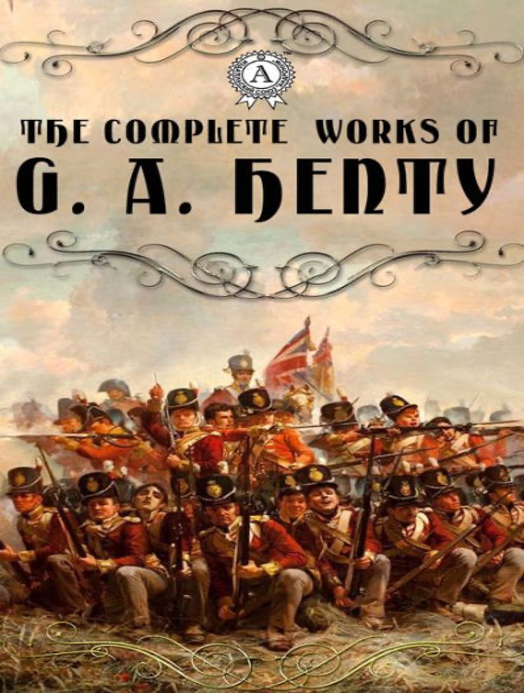
Henty’s books embodied the spirit of so-called “Muscular Christianity.” This Victorian movement glorified the pious athleticism and virile masculinity of tough, white saviors who would happily knock heads together (and kill if need be) for the glory of god, king, country and empire.
Always ready to save the brutish, lower-class savages from themselves, Henty’s heroes enthralled impressionable juveniles, like Pearson, who lapped up this macho vision of a missionizing, tough-love fundamentalism that was hopped up on just wars and imperial steroids.[11] “To be a true hero,” explained Henty when interviewed, “you must be a true Christian.”[12]
Henty’s 122 novels were riddled with white supremacist heroes who spouted the era’s outrageously popular racist, sexist and anti-semitic beliefs. His books also targeted left-wing, cartoon villains from the ruthless labour leaders of striking English coal miners[13] to the eroticized socialist women who ran loose in the 1871 “Paris Commune.”[14]
Considering his class and the strong religious leanings of his family and community, it is not surprising that Pearson would be so captivated by Henty’s writings. While Pearson’s 1972 memoir offers no critique of Henty, it praises the author’s historical fiction for having provided a knowledge of the world that informed and inspired him throughout his political career:
“His exciting stories based on history’s more romantic episodes stirred my imagination mightily and, I suspect, had much to do with my liking for and concentration on history in my educational progress. When years later I traveled extensively abroad as Canada’s Secretary of State for External Affairs, there was hardly a place I visited which I had not known through that prolific but now almost forgotten writer of adventure stories for boys.”[15]
Pearson’s exceedingly sheltered childhood kept him cozy in the warmth of positive feelings for imperialism. “[T]he parish was my world,” he confessed. “As for the rest of the world, I thought about it … largely in terms of the British Empire which was looking after the ‘lesser breeds’ and keeping the French and Germans under control.”[16]
Admitting that his was “an absorbing mind rather than a questioning mind,” Pearson also disclosed that he had “a rather superficial approach to life.” His “limited” world, Pearson says, “did not broaden much” until 1913 when, at age 16, he entered Toronto’s Victoria College.[17]
Named for Queen Victoria, and founded by the Wesleyan Methodist Church in 1836, this was no breeding ground for radical thought; it was a hotbed of imperialist education.
Rather than freeing Pearson’s mind from its fetters, college life further narrowed Pearson’s “limited” worldview. And, it was here that Pearson first made contact with influential men who led him along the political path to power.
Victoria College was where he began what he called his “long and … rewarding association”[18] with Vincent Massey, a history lecturer and dean of the residence building which his family had built and furnished. Massey’s Methodist father, owning one of Toronto’s biggest industrial concerns, had close links to the highest echelons of the Liberal Party. Massey was already a good friend of Mackenzie King, who became Canada’s longest-standing prime minister.
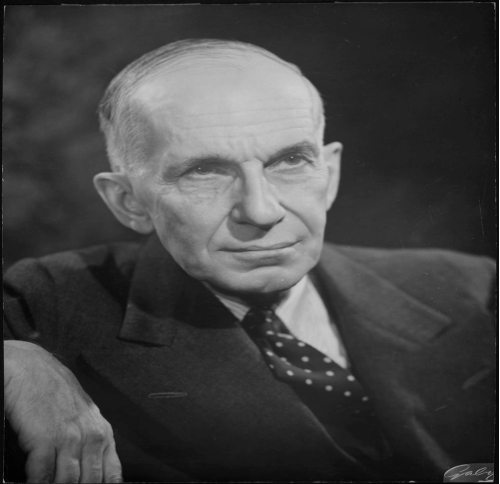
Massey became one of Pearson’s most important Methodist mentors. His deeds included being a leader of Toronto’s Cecil Rhodes-inspired Round Table Society (1911-18); marrying Alice Parkin, daughter of Sir George Parkin, secretary of The Rhodes Trust (1915); being appointed to Prime Minister Mackenzie King’s cabinet war committee (1918) and to the Liberal cabinet (1925); being appointed Canada’s first envoy to the U.S. (1926-30) and its high commissioner to Britain (1930, 1935-46); being president of England and Wales’ National Liberal Federation (1932-35); being made Canada’s delegate to the League of Nations (1936) and being appointed to represent the Queen as Canada’s governor general (1952-59).[19]
Massey, who Pearson notes was “personal friends of the Royal Family, and … seemed to know every duke by his first name,”[20] was able to open doors for Pearson throughout his career. This included funding Pearson’s BA and MA studies at Oxford (1923-25).[21]
Pearson’s subservience to the moneyed interests of empire helped ensure his rise through the Department of External Affairs. He joined that bureaucracy in 1928, during the King government, but when Conservative Prime Minister Richard “Iron Heel” Bennett took power in 1930, “Pearson was a beneficiary.”[22]
Bennett, who was also a devout Methodist, earned his nickname after an inflammatory 1932 speech in which he said:
“What do these so-called groups of Socialists and Communists offer you? They are sowing their seeds everywhere…. [T]hroughout Canada this propaganda is being put forward by organizations from foreign lands that seek to destroy our institutions. And we ask that every man and woman put the iron heel of ruthlessness against a thing of that kind.”[23]
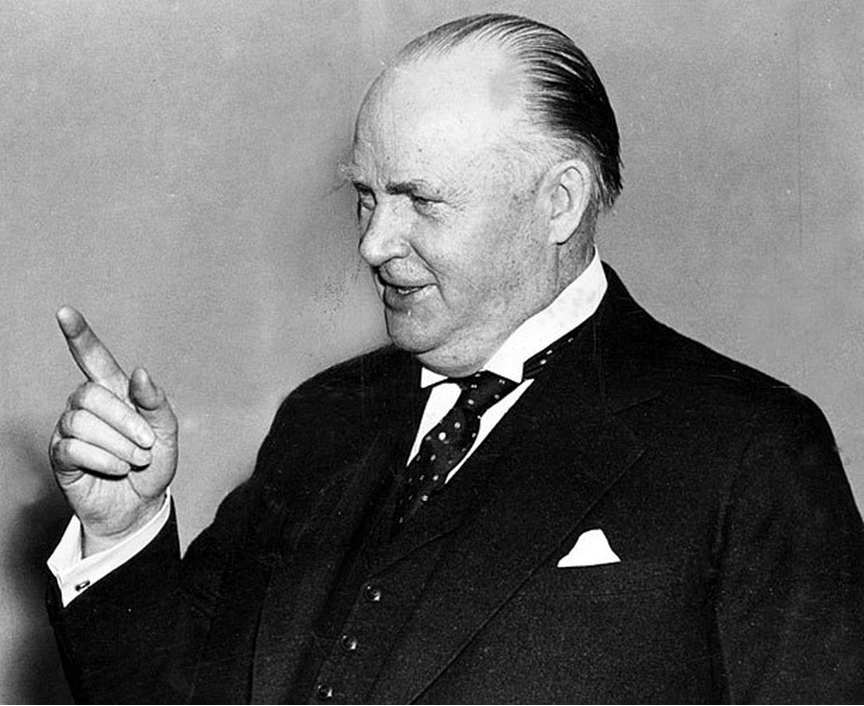
Crushing communism was clearly the order of the day, and Pearson was ambitious and eager to comply.
Talent-spotted by Bennett, Pearson was soon appointed to two royal commissions on economic issues. As journalism professor Andrew Cohen noted: “Pearson liked Bennett who treated him as a protegé.”
In early 1935, Pearson accompanied Bennett to London where they took part in the Jubilee to celebrate King George V’s 25-year reign. During their lavish sea voyage with its sumptuous cuisine, Pearson learned he would receive the Order of the British Empire and asked Bennett for a raise of $25 per week.[24]
This increase boosted Pearson’s salary by an extra $25,000 per year in today’s dollars. This was distasteful considering all those who were hungry for food and justice during the Great Depression.
Unmentioned by Cohen or Pearson is that, between 1932 and 1935, Bennett’s government rounded up 170,000 single, unemployed, urban men and forced them into slavery in army-run “Relief Camps.”
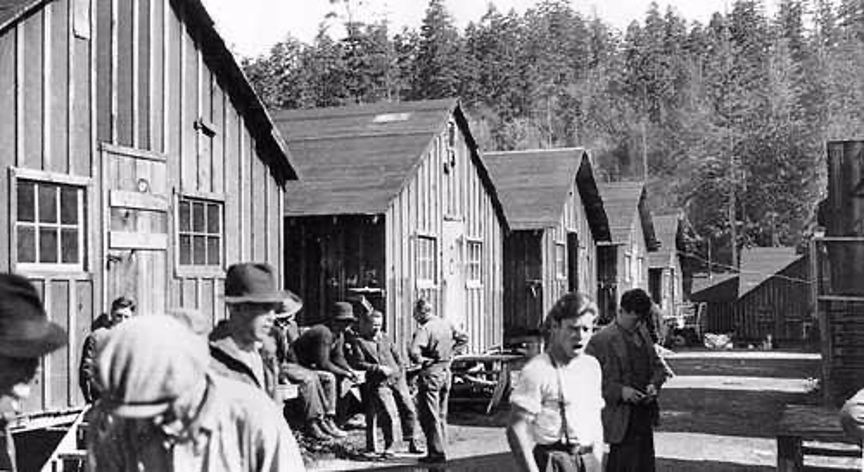
General Andrew McNaughton’s internment plan makes it clear why. “In their ragged platoons,” he explained to the cabinet, “here are the prospective members of what Marx called the ‘industrial reserve army, the storm troopers of the revolution.’”[25]
General McNaughton further told Bennett that “[b]y taking the men out … of the cities” and forcing them into remote work camps, “we were removing the active elements on which the ‘red’ agitators could play.”[26]
In 1935, Bennett approved Pearson’s posting to Canada’s High Commission in London. When Bennett was replaced by King, Pearson’s move was confirmed and he continued his climb, becoming second in command under High Commissioner Vincent Massey (1939-42).
In 1940, Pearson was recruited by Sir William Stephenson to be a “King’s messenger” carrying secret documents to Europe. Nicknamed “the Quiet Canadian,” Stephenson was the Canadian intelligence agent, codenamed “Intrepid,”[27] who inspired Ian Fleming’s fictional, anti-communist superspy, 007.[28]
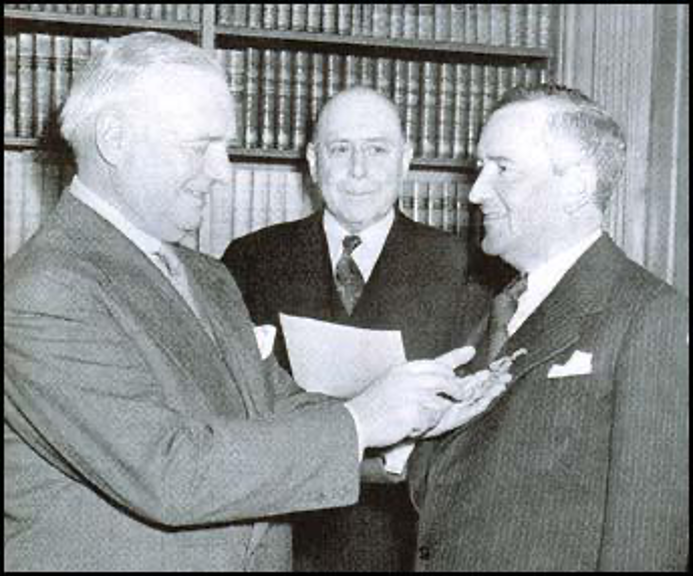
James Bond was also the violently racist and sexist Cold War equivalent of the Victorian era’s manly, white, imperial adventure heroes, so admired by Pearson.
From London, Pearson was transferred to Washington, D.C., where he was Canada’s ambassador and envoy extraordinaire to the U.S. (1942-46).
After returning to Ottawa, he was appointed foreign minister for the last few months of Prime Minister King’s time in office (1948). When King’s protégé, Louis St. Laurent, took over, he retained Pearson as foreign minister (1948-57).
Pearson’s early decades of pliable innocence were over. Having been moulded and mentored into form by family, church, schools and government, he had thoroughly internalized the deceitful scripts of elite institutions.
But though he became a manager and manipulator in his own right, Pearson’s role on the global stage was still directed by external forces in Washington and London. While just following his social orders, Pearson’s acts of complicity in Cold War coups, wars, invasions and occupations cannot be excused. He was culpable for the criminality in which he willfully engaged. Let’s look at a few examples.
The Korean War and Its Planning, 1947-1953
Pearson was a strong supporter of the Korean War (1950-1953), which devastated the Korean peninsula and left a legacy of conflict and division that persists to this day.
Pearson considered the war part of a moral crusade against communism.
His understanding overlooked the fact that the northern communist regime, led by Kim Il-Sung, had led the fight against Japanese colonialism. By contrast, the southern regime, led by Syngman Rhee and dominated by Japanese colonial collaborators, killed over 100,000 of its own citizens and launched raids into the north, all of which provoked the onset of the war.

Pearson’s hawkish position contrasted with Prime Minister Mackenzie King’s, who said that “Canada should not automatically support the United States in all its endeavors.”[29]
Pearson also clashed with Defense Minister Brooke Claxton who opposed sending Canadian troops to Korea presciently because the U.S. was “getting [Canada] into something to which there is really no end.”[30]
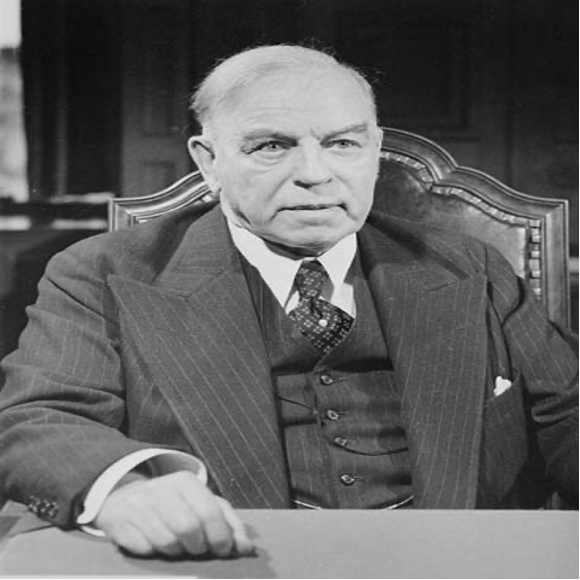
Mackenzie King [Source: wikipedia.org] 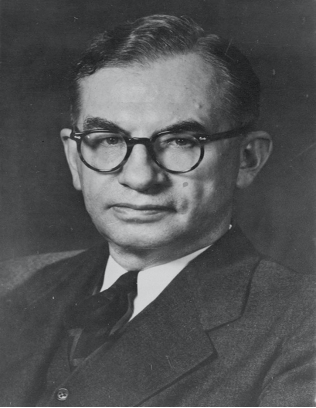
Brooke Claxton [Source: wikipedia.com]
When Pearson was dispatched to Washington to meet with President Harry S. Truman in 1948, he conspired behind the scenes with Truman to undermine King’s direct orders regarding the pursuit of an independent Canadian foreign policy, and assisted U.S. State Department officials in crafting a letter that urged King to support the Korean War.[31]
King’s successor, Louis St. Laurent, assisted the war effort by deploying a Royal Canadian Air Force (RCAF) squadron of transport planes to airlift U.S. troops, weapons and other materiel across the Pacific.

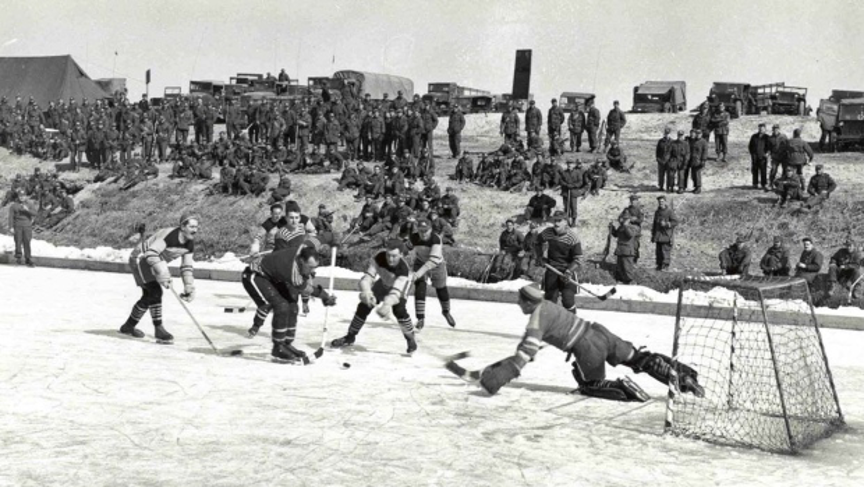
Military historian David Bercusson,[32] who continues to spread official narratives promoting this and other wars, wrote:
“Pearson was correct about what the Korean War meant in the global confrontation between Soviet Communism and the Western democratic powers and correct too in believing that Canada could not sit out the war if the Americans insisted that Canadian troops were needed. He was far wiser than Claxton in knowing this. With Pearson leading the way, Claxton came on board.”[33]
Pearson told St. Laurent that he supported troop deployments based on his anti-communist views about “the menace which faces us, … the expression of that menace in Korea, and the necessity of defeating it there by United Nations action.” Pearson’s efforts paid off. “St. Laurent came around,” said Bercusson, because “he and the nation really had little choice.”[34]
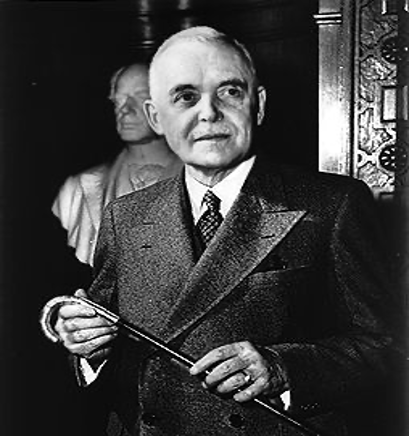
The speech St. Laurent gave over the radio announcing Canada’s commitment to the war was probably crafted in part by Pearson. It was deep in Orwellian newspeak:
“The action of the United Nations in Korea,” St. Laurent intoned, “is not war; it is police action intended to prevent war by discouraging aggression.” Since “the war to end all wars” had already come and gone 30 years hence, the Korean War was framed as “important to all of us who want to avoid another world war.” The need to “defeat the Communist aggressors in Korea,” said St. Laurent, was like fighting “fascist aggression” in WWII. He concluded his deceit with “We owe it to to ourselves, to each other, to our children, and each other’s children … to prevent the disasters of a third world war.”[35]
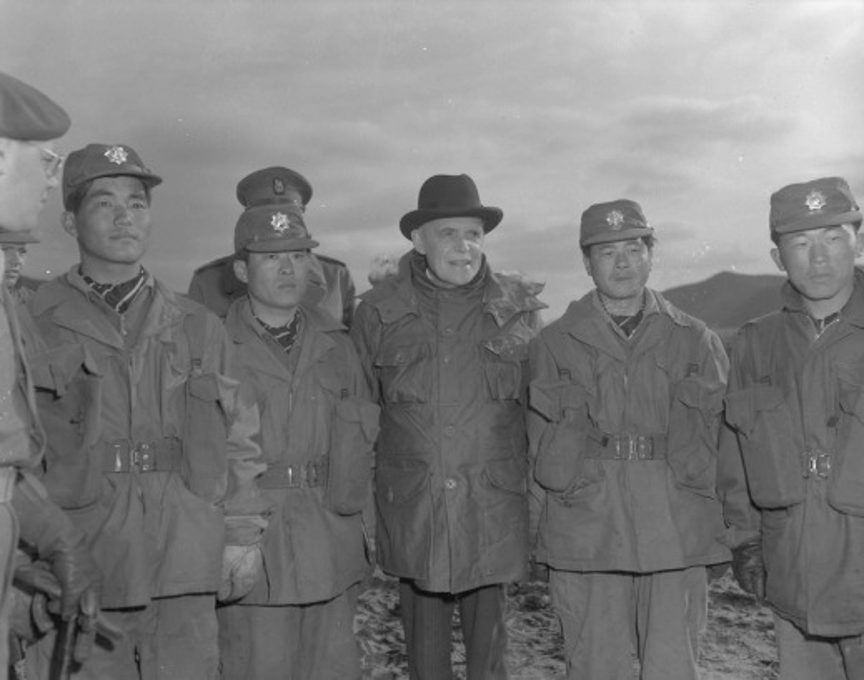
This launched Canada’s four-year collaboration—under the UN’s respectable cover—in a barrage of napalm-saturated bombings that slaughtered some three or four million Koreans.
This supposed non-war, also caused “six to seven million” more to be “rendered refugees,” says historian Jeremy Kuzmarov, who also notes that the onslaught destroyed “8,500 factories, 5,000 schools, 1,000 hospitals, and 600,000 homes.”[36]
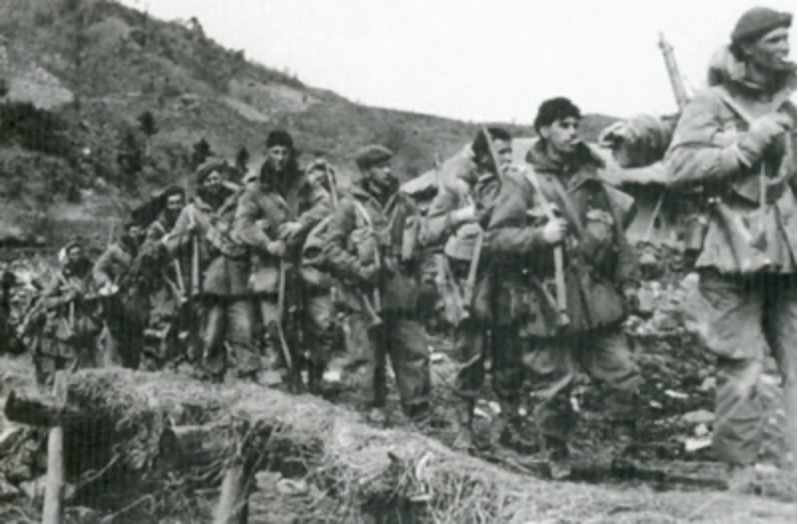
To aid and abet this mayhem, Canada supplied its good name, plus more than 20,000 troops (516 of whom died), numerous war planes, eight destroyers and a wealth of strategic minerals and military hardware.
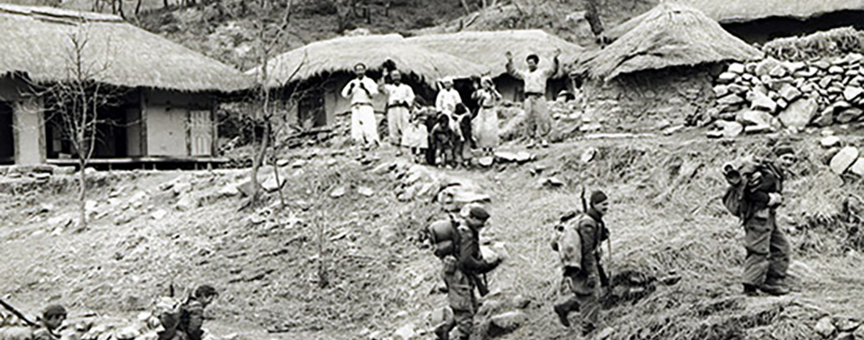
In return, the St. Laurent government exploited the war as an excuse to vastly expand Canada’s army, navy and air force and to accelerate the production of jet fighters, jet engines, naval vessels, weapons, ammunition, radar and more.
“We are working in the closest co-operation with the United States,” said St. Laurent, so “that our joint resources and facilities are put to the most effective use in the common defence [sic] effort.” The government, he went on, was also “looking forward confidently to an acceleration and an intensification of our joint [military] production efforts” through the “U.S.-Canada industrial mobilization planning committee.”[37]
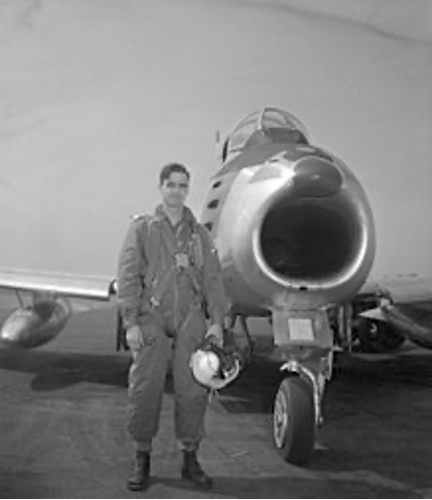
While devastating Korea itself, the Korean War sparked the blossoming of Canada’s military-industrial complex, which fueled its complicity in Cold War adventures for decades to come.
Similarly, anti-communism was harnessed by Western governments to repress the civil liberties of anti-war activists. Quebec’s “Padlock Law” (1937-57) made it illegal to copy, publish or distribute anything deemed pro-communist. Although the King and St. Laurent governments could have struck down this law, they didn’t. It was used against peace activists opposing the Korean War.
In May 1951, an “anti-subversion squad” raided a Montreal home where about thirty labor and civil rights activists were meeting with James Endicott, president of the Canadian Peace Congress. Literature was seized and male police invasively searched activists, including the women, who lodged a complaint to Pearson’s office, which did nothing.[38]
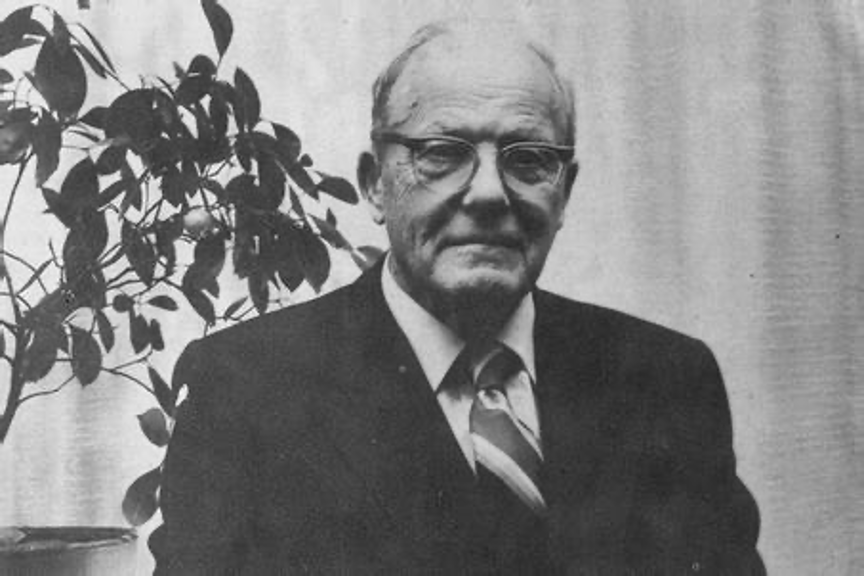
In January 1952, Endicott denounced the “Padlock Law” at a meeting in London, England. “Under American pressure,” he reported, Canada’s treason act had been amended “so that a cabinet committee can order secret arrests and hold people indefinitely and incommunicado without trial. They are doing that against peace workers.”[39]
Coup in Iran, 1953
Pearson’s foreign ministry supported the coup that installed Shah Mohammad Reza Pahlavi as Iran’s dictator in 1953.
This CIA/MI5-led coup ousted Mohammad Mosaddegh’s elected government after it dared to nationalize Iran’s UK-owned oil industry in March 1951. Although not a socialist, Mosaddegh worked with Iran’s communist party, Tudeh, which had played a key role in Iran’s struggle to gain control of its own oil resources.
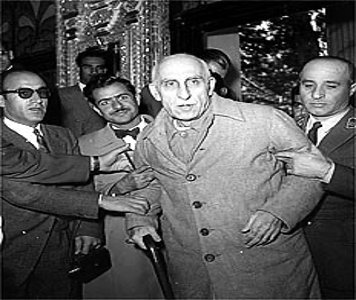
As revealed by anti-war writer Yves Engler, Pearson “was not happy with the Iranian’s move”:
In May 1951 External Minister Lester Pearson told the House of Commons the “problem can be settled” only if the Iranians keep in mind the “legitimate interests of other people who have ministered to the well-being of Iran in administering the oil industry of that country which they have been instrumental in developing.”[40]
Mossadegh’s duly-elected government also angered Pearson. “In their anxiety to gain full control of their affairs by the elimination of foreign influence,” he told parliament, Iran had exposed itself “to the menace of communist penetration and absorption—absorption into the Soviet sphere.”[41]
As Engler notes, “Pearson did not protest the overthrow of Iran’s first elected prime minister” and three days after the coup, Canada’s ambassador expressed concern with what he called the “disturbing factor” of “the continued strength of the Tudeh party.”[42]
In response, the Shah’s CIA-trained secret police (SAVAK) quickly began arresting thousands of Tudeh members. By 1958, SAVAK torture and assassination campaigns had decimated Tudeh and other popular, democratic forces.[43] This “progress” allowed Canada to begin diplomatic relations with Iran in 1955.
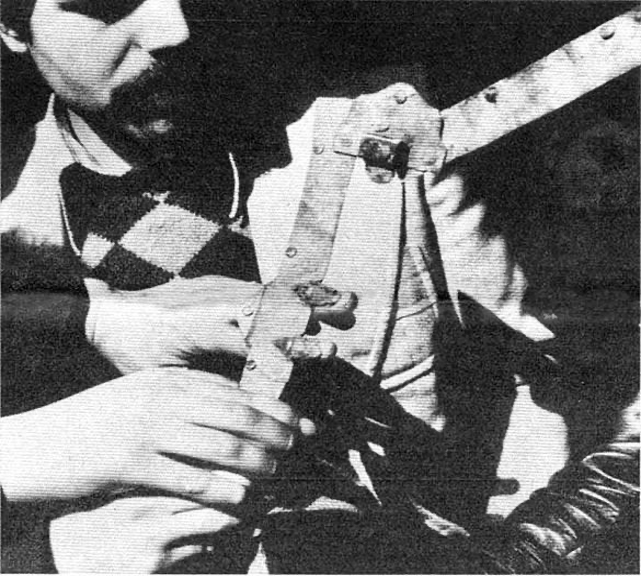
By May 1965, when deposed Prime Minister Mossadegh was still under arrest, Pearson was prime minister and hosted the Shah’s state visit to Canada.
Upon his arrival in Ottawa, aboard a Canadian military plane, the Shah was greeted by Pearson, Foreign Minister Paul Martin, Sr., and Governor General George Vanier, who literally gave him the red-carpet treatment.
Vanier intoned “I greet Your Imperial Majesty as an able and valiant head of state and as a great leader with progressive policies,”[44] while Pearson said the Shah “had given outstanding leadership in bringing his country forward into the modern world.”[45]
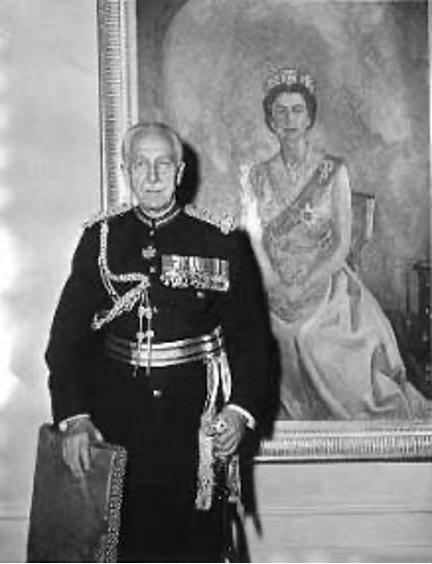
During his eight-day visit to five cities, the Shah attended top-government meetings, inspected an honor guard, waved to the public, laid a wreath, spoke at press conferences and elite clubs, was feted at gala luncheons and black-tie dinners, dined privately at Pearson’s home, was honored at a state banquet and reception by Vanier in his palatial mansion, and was regaled by Canada’s mass media. Pahlavi and his Empress were a hit.[46]
Special police precautions were taken for fear of Iranian student protests, which the Shah “dismissed … as the work of communists.”[47]
Summing up the visit, Pearson said it had “brought our two countries even closer together in our approach to problems of peace and the United Nations.”[48]
Coup in Guatemala, 1954
A CIA-led coup toppled Guatemala’s elected government and ushered in decades of dictatorships that killed about 200,000 people.
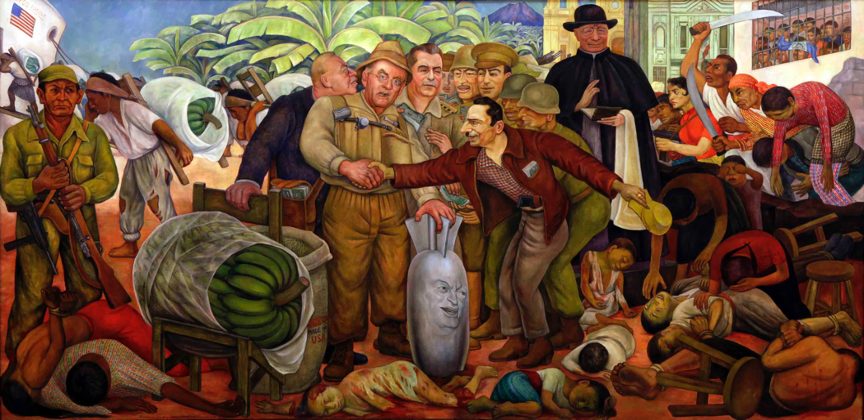
As a U.S. State Department official said, Guatemala’s elected President Jacobo Arbenz—the target of the coup—had a “broad social program” to aid “workers and peasants in a victorious struggle against the upper classes and large foreign enterprises.”
This, he admitted, had “strong appeal to the populations of Central America.”[49] Arbenz was not allowed to pose the threat of a good example.
Even before Arbenz’s 1950 election, Ottawa’s trade commissioner in Guatemala had characterized him as “unscrupulous, daring and ruthless, and not one to be allayed in his aims by bloodshed or killing.”[50]
Prior to the coup, Arbenz’s Foreign Minister Guillermo Toriello asked Canada to allow embassies to open in their two countries.
Pearson’s department refused. “At external affairs and in Canadian board rooms,” said reporter Peter McFarlane, “the coup was chalked up as another victory of the Free World against the [Red] Menace.”[51]
Afterwards, U.S.-led counter-insurgency operations directed against left-wing rebels who sought to restore Arbenz’s political program benefited from the use of Canadian military hardware. The key U.S. warplanes used in this CIA operation were P-47 and F-47N fighter planes and C-47 and C-54 cargo planes. Owned and operated by the CIA, they were flown by American pilots.[52]
These aircraft in the CIA’s “Liberation Air Force” were powered by Wasp-series engines built in Montreal, Quebec, by Pratt & Whitney Canada (PWC).[53]
Throughout the 1980s, when the Guatemalan air force attacked villages, they employed U.S. Bell 212 and 412 helicopters—made famous in the Vietnam War—that were powered by PWC’s PT6T engines.[54]
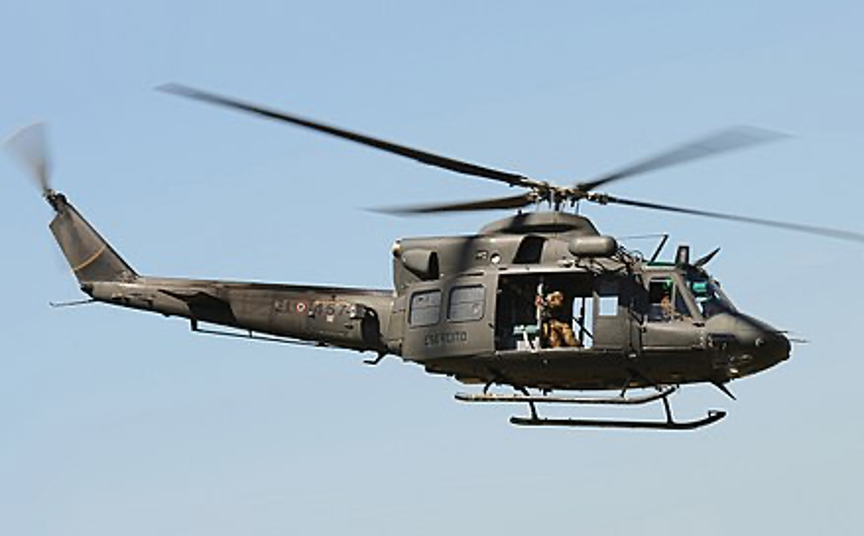
PWC has long been one of the highest government-subsidized war industries in Canada. For example, between 1982 and 2006 it was Canada’s top corporate welfare recipient, raking in about $1.5 billion.[55]
Vietnam War, 1952-1974
From the beginning, Pearson was a gung-ho supporter of the Vietnam War. When France initiated the first Indochina War (1946-1954) in an attempt to reclaim its former colony, Pearson led Canadian efforts to supply weapons for use by French forces in Indochina (now Vietnam, Laos and Cambodia).[56]
This was done under the radar through NATO’s Mutual Aid Program. Between 1950 and 1954 alone, about $650 million (in 2021 dollars) worth of Canadian “armaments, ammunition, aircraft, and engines were transferred … to the Indochina war theatre.”[57]
In 1952, Pearson “okayed the deal” to allow Canadian arms, sold to France for use in Europe only, to be diverted to Indochina. This materiel included “antitank and anti-aircraft guns, ammunition, rangefinders and telescopic sights.” Behind the cabinet’s back, Pearson decided that arming France’s Indochina War was lawful because it “help[ed] assure the preservation of peace.”[58]
In one of Pearson’s many 1951 tirades affirming his support for that war, he suggested that if the independence of Indochina were to fail, “all of South-East Asia, including Burma, Malaya and Indonesia, with their important resources of rubber, rice and tin, might well come under communist control.”[59]
Pearson at the same time was claiming in the early 1950s that the “‘Soviet colonial authority in Indochina’ appeared to be stronger than that of France.” Considering that there was “not a Russian anywhere in the neighborhood,” Noam Chomsky wrote, “[o]ne has to search pretty far to find more fervent devotion to imperial crimes than Pearson’s declarations.”[60]
Pearson’s collaboration in the Vietnam War included his backing of Canadian government collaboration in “spying, weapons sales, and complicity in the bombing of the North.”[61]
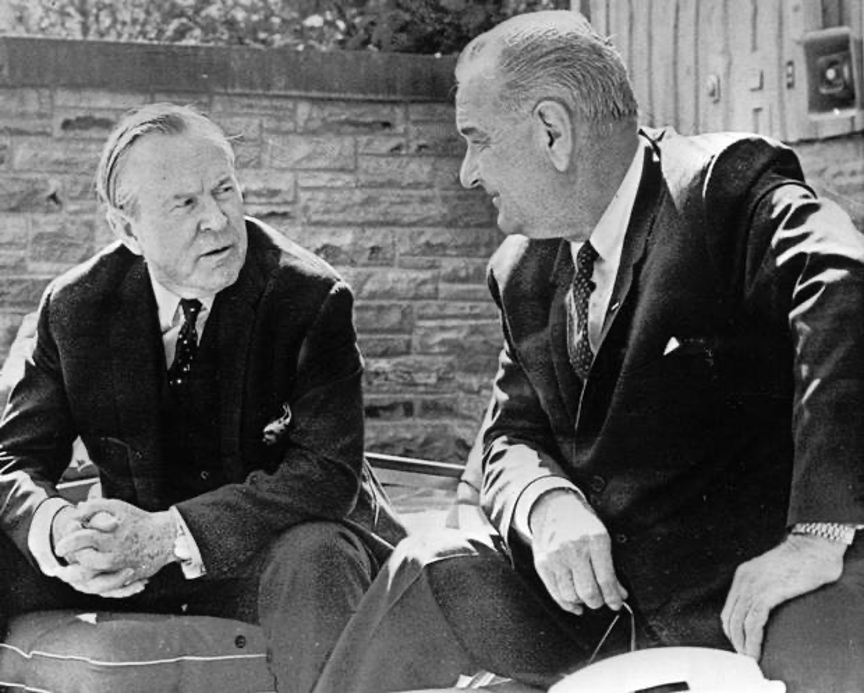
Many Canadians believe the myth today that Pearson helped keep Canada out of the Vietnam War. However, 40,000 Canadians joined the U.S. armed forces during the war.[62] This was 50% more than the 26,000 Canadian soldiers who had served in Korea.
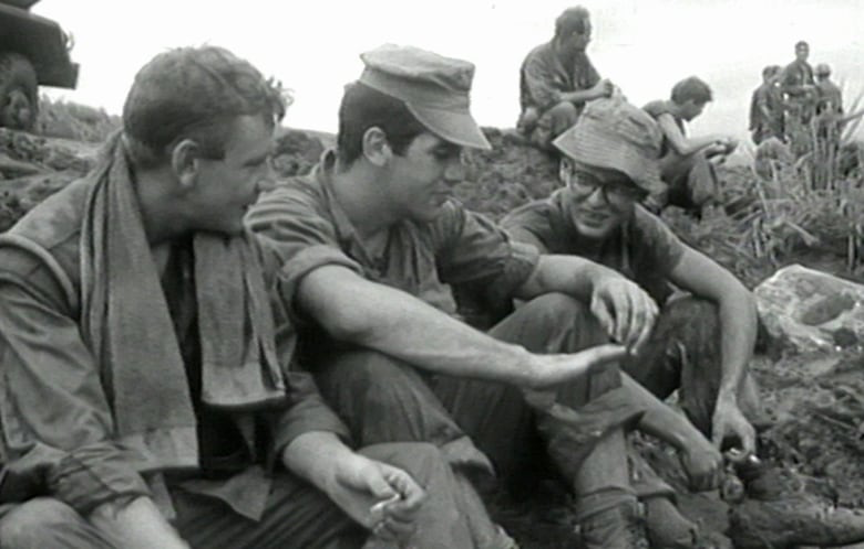
In 1954, when Pearson was minister of external affairs, he helped gain American backing for Canada’s bid for a seat on the International Control Commission (ICC)—whose purpose was to enforce the 1954 Geneva accords.
Pearson served as the handler of Canada’s ambassador to the U.S., Arnold Heeney, who forged an agreement with U.S. Deputy Undersecretary of State Robert Murphy, that Canada would illegally supply the U.S. with secret intelligence obtained through its involvement in the ICC mission.[63]

Canada’s best-known ICC spy was Blair Seaborn, a long-time friend of America’s ambassador to South Vietnam, Henry Cabot Lodge, Jr. In late April 1964, U.S. Secretary of State Dean Rusk met Prime Minister Pearson and External Affairs Minister Paul Martin, Sr., to discuss the “Seaborn Mission.” A month later Pearson conveyed to Johnson his “willingness to lend Canadian good offices to this endeavour.”
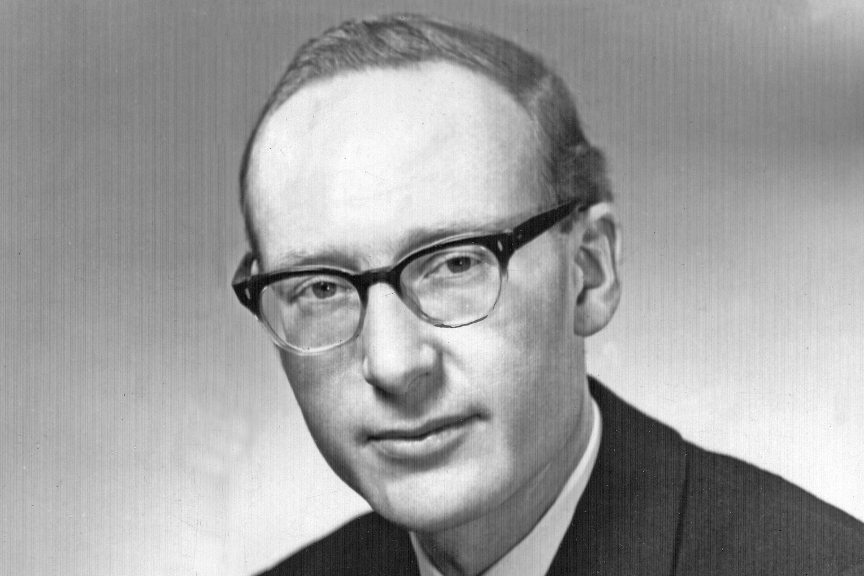
The Pentagon Papers later revealed that Pearson told Johnson at this meeting that, although he “would have great reservations about the use of nuclear weapons,” in Vietnam, America’s “punitive striking” with “iron bomb attacks” (i.e., unguided, air-dropped conventional munitions) was fine.[64]
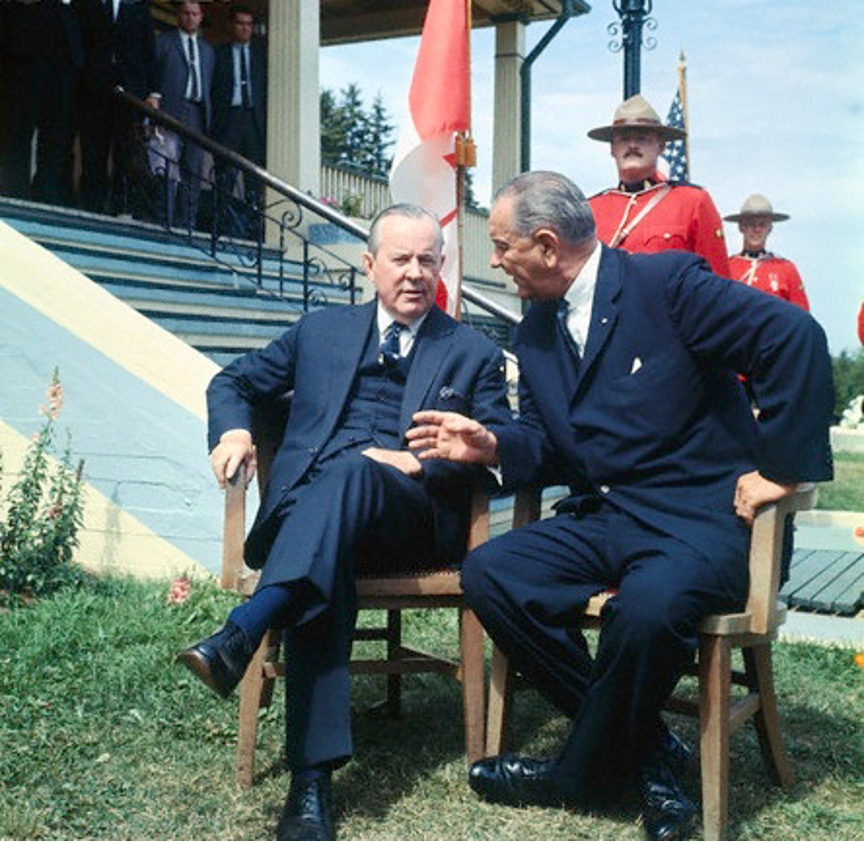
Seaborn conveyed U.S. threats to the North Vietnamese that, unless they surrendered, the U.S. would unleash massive military attacks.
Seaborn also “gathered intelligence for U.S. authorities” on many strategic issues that aided and abetted America’s war. The Pentagon Papers showed that the U.S. informed Canada, seven months in advance, of closely guarded U.S. plans for a major bombing campaign against the north in December 1964.[65]
Victor Levant’s groundbreaking book, Quiet Complicity: Canadian Involvement in the Vietnam War (1986), reveals that Pearson’s government (he was prime minister from 1963 to 1968) was aiding and abetting domestic war industries to cash in on the bonanza.
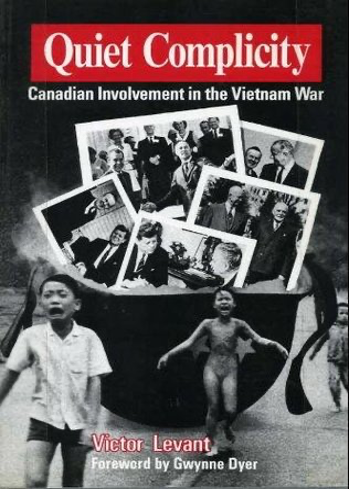
This was despite the fact that, as a member of the ICC, one of Canada’s duties was “to restrict the entry of arms into Vietnam from anywhere.”[66] But, said Levant, “[f]ar from trying to curtail U.S. purchases of Canadian military equipment, the government in Ottawa actively encouraged the process” with grants to so-called “defense industries” between 1964 and 1968, that were worth just over $1 billion in 2021 dollars.[67]
This investment of taxpayers’ money paid off, at least for Canadian corporations that received over $2.16 billion (in 2021 dollars) “in 1965 [alone] by making military equipment, ranging from green berets to airplanes, for the U.S. war effort in Vietnam.”[68]
Prime Minister Pearson tried to absolve himself and the government of complicity in this war profiteering by claiming in 1967 that Canada could not determine the whereabouts of military equipment purchased in Canada by the U.S., though he conceded that a “small percentage of Canadian arms could be reaching the battlefield in Vietnam.” [69]
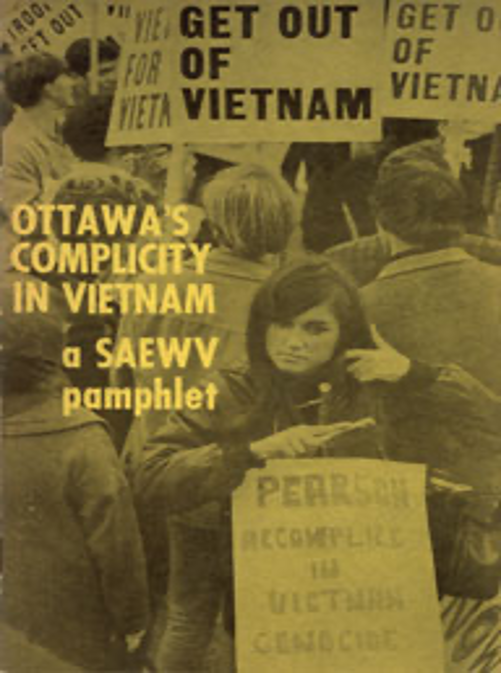
While cheered by virulently anti-communist groups, Pearson became a main target of the anti-war protesters who carried banners that read “End Canadian complicity in Viet Nam War,” “Pearson accomplice in genocide” and “Accomplice in mass murder.” A chant that was familiar in those days,was “Pearson, Martin, LBJ, how many kids did you kill today?”[70]
On the nation’s 100th anniversary (July 1, 1967) in Montreal, when thousands marched to protest Canada’s role in the Vietnam War, French chants included “Johnson assassin. Pearson Complice.”[71] The fact that Pearson was an accomplice to mass murder in Vietnam was then well known to the peace movement. This institutional memory has now been all but erased.
Stay tuned for Part 2, coming shortly.
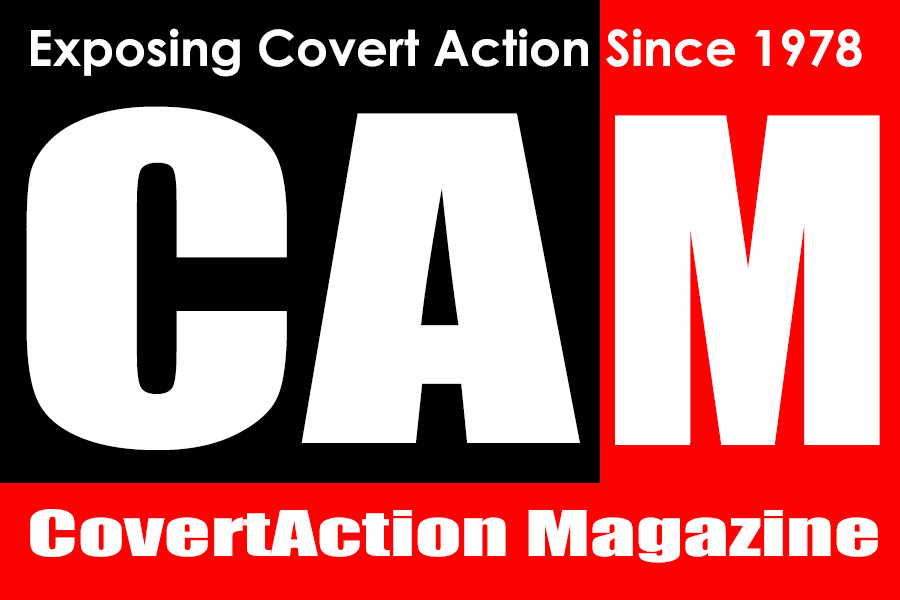
(Thanks to Eric Mills for his work copy editing an early version of this article.)
[1] Ian MacKay and Jamie Swift, Warrior Nation: Rebranding Canada in an Age of Anxiety, 2012, p. 128.
[2] Ibid., p. 118.
[3] Richard Sanders, “War Mania, Mass Hysteria and Moral Panics,” Captive Canada, Press for Conversion!, March 2016, pp. 5-14. http://bit.ly/RedScare-1
[4] See Jeremy Kuzmarov and John Marciano, The Russians Are Coming, Again: The First Cold War as Tragedy, the Second as Farce (New York: Monthly Review Press, 2018).
[5] Richard Sanders, “Left-Right Camps: A Century of Ukrainian Canadian Internment,” Captive Canada, op. cit., pp. 40-55. https://coat.ncf.ca/P4C/68/68_40-55.htm
[6] Lester Pearson, Statements and Speeches, 55/10, March 24, 1955, cited by Levant, op. cit., pp. 12-13.
[7] Richard Sanders, “The Occupation(al) Psychosis of Empire-Building Missionaries,” Captive Canada, op. cit., pp. 18-19.https://coat.ncf.ca/P4C/68/68_18-19.htm
[8] John English, “Pearson, Lester Bowles,” Dictionary of Canadian Biography, 2003- http://bit.ly/EdwinP
[9] Lester Pearson, Mike: The Memoirs of the Rt. Hon. Lester B. Pearson, Vol.1, 1972, p. 10.
[10] Ibid.
[11] For more on this genre and its Canadian exemplar, Charles Gordon, see Richard Sanders, “Religious Guardians of the Peaceable Kingdom: Winnipeg’s Key Social-Gospel Gatekeepers of Canada West,” Captive Canada op. cit., pp. 22-29. https://coat.ncf.ca/P4C/68/68_22-29.htm
[12] Ray Van Neste, Review of The Boy’s Guide to the Historical Adventures of G. A. Henty, March 3, 2006. http://rayvanneste.com/?p=686
[13] G.A. Henty, Facing Death: A Tale of the Coal Mines, 1883. https://books.google.ca/books?id=rRcCAAAAQAAJ
[14] Matthew Beaumont, “Anti-Communism and the Cacotopia,” Utopia Ltd.: Ideologies of Social Dreaming in England 1870-1900, 2005, pp. 152-154. https://brill.com/view/book/9789047407096/BP000006.xml
G.A. Henty, Woman of the Commune: A Tale of Two Sieges of Paris, 1895. https://books.google.ca/books?id=9mZWAAAAMAAJ
[15] Pearson 1972, op. cit., p. 10.
[16] Ibid., p. 15
[17] Ibid., pp. 14-15.
[18] Ibid., p. 15.
[19] Claude Bissell, The Young Vincent Massey, 1981, passim.
[20] Pearson 1972, op. cit., p. 105.
[21] Ibid., p. 45.
[22] Andrew Cohen, Lester B. Pearson, 2008.
https://books.google.ca/books?id=JyBrNgMJELIC&pg=PT38
[23] Thomas Green, “Bennett Raps Socialism, Communism,” Saskatoon Star-Phoenix, Nov. 10, 1932, p. 5. https://www.newspapers.com/image/508724453
[24] Cohen 2008, op. cit.
[25] Canada: A People’s History, Vol. 2, http://books.google.ca/books?id=2fcXAAAAYAAJ
[26] In Jean Barman, The West Beyond the West: A History of British Columbia, 1991. http://books.google.ca/books?id=JbYe6fCOSTAC
[27] A Man Called Intrepid: The Incredible True Story of the Master Spy Who Helped Win WWII, 1976, pp. 191, 216.
https://books.google.ca/books?id=Zj-CDwAAQBAJ&pg=PT255
https://books.google.ca/books?id=Zj-CDwAAQBAJ&pg=PT287
[28] Guy F. Burnett, “Ian Fleming’s Coldest Warrior: The Anticommunist Origins of James Bond,” Dissident, Nov. 17, 2015. http://bit.ly/antiRedBond
(The above archived article, from the anti-communist, “Victims of Communism Memorial Foundation” website, celebrates both Fleming and his Bond character as those “who fought to save the world from tyranny and oppression.”
[29] Pearson 1972, p. 139.
[30] David Jay Bercuson, Blood on the Hills: The Canadian Army in the Korean War, 1999, pp. 31-32. https://books.google.ca/books?id=eCizi80V1M0C
[31] Pearson 1972, op. cit., pp. 140-141. https://books.google.ca/books?id=nXM2CwAAQBAJ&pg=PA140
[32] Bercuson is a director of two right-wing, Calgary-based think tanks, the Centre for Military and Strategic Studies (funded by the Canadian war department’s “Security and Defence Forum”), and the Canadian Defence and Foreign Affairs Institute (which has accepted funding from General Dynamics and publicly promoted the company’s exports of major Canadian-made weapons systems, such as LAVs, to Saudi Arabia.
[33] Ibid., p. 33.
[34] Ibid.
[35] “St. Laurent Text on Resisting Reds,” Windsor Daily Star, August 8, 1950, p. 14.
https://www.newspapers.com/clip/72910987/the-windsor-star/
[36] Jeremy Kuzmarov, “The Korean War: Barbarism Unleashed,” United States Foreign Policy, History and Resource Guide website, 2016. http://peacehistory-usfp.org/korean-war/
[37] Windsor Daily Star, op. cit.
[38] See author’s collection of seven newsclips, May 25-28, 1951.
https://www.newspapers.com/clippings/#query=padlock&user=1155887
[39] “Says working for peace in America hard,” Ottawa Citizen, Jan. 10, 1952, p. 10.
https://www.newspapers.com/clip/73516103/the-ottawa-citizen/
[40] Engler 2012, citing Pearson, Hansard, May 14, 1951, 3002.
[41] Lester Pearson, Hansard, Oct. 22, 1951, p. 253, cited by Engler, op. cit., pp. 75.
[42] Engle, ibid., p. 76.
[43] Ervand Abrahamian, Tortured Confessions: Prisons and Public Recantations in Modern Iran, 1999, pp. 89-101. http://bit.ly/SAVAK-Tudeh
[44] “Shah, Empress in Ottawa,” Ottawa Journal, May 19, 1965, p. 1. https://www.newspapers.com/clip/73543166/the-ottawa-journal/
[45] “Shah starts visit,” Ottawa Citizen, May 19, 1965, p. 1. https://www.newspapers.com/clip/73528451/the-ottawa-citizen/
“Shah in Canada,” Ottawa Citizen, ibid., p. 3. https://www.newspapers.com/clip/73534362/the-ottawa-citizen/
[46] “Shah has busy schedule here,” Ottawa Citizen, May 17, 1965, p. 3. https://www.newspapers.com/clip/73524704/the-ottawa-citizen/
“Shah of Persia in Canada, 1965.” https://www.britishpathe.com/video/shah-of-persia-in-canada
(Note: These film clips from the Shah’s visit include footage of the state dinner with Governor General Vanier at Rideau Hall.)
[47] “Shah in capital,” Ottawa Citizen, May 19, 1965, p. 3. https://www.newspapers.com/clip/73534362/the-ottawa-citizen/
[48] “Royal Visits Top News Events,” Brandon Sun, May 31, 1965, p. 12. https://www.newspapers.com/clip/73525463/the-brandon-sun/
[49] Cited by Noam Chomsky, Deterring Democracy, 1991, p. 419. http://bit.ly/Chomsky1991
[50] James Rochlin, Discovering the Americas: Evolution of Canadian Foreign Policy towards Latin America, 1994, p. 35. http://bit.ly/Roch94
[51] Peter McFarlane, Northern Shadows: Canadians in Central America, 1989, pp. 98, 100, cited by Engler op. cit., p. 79.
[52] Guatemala: Air Force History
http://www.aeroflight.co.uk/waf/americas/guatemala/Guatemala-af-history.htm
[53] Pratt & Whitney Canada ; http://bit.ly/PWC-WASP; Republic P-47 Thunderbolt
https://en.wikipedia.org/wiki/Republic_P-47_Thunderbolt; Douglas C-47 Skytrain [Dakota]
https://en.wikipedia.org/wiki/Douglas_C-47_Skytrain#Postwar_era; Douglas C-54 Skymaster
https://en.wikipedia.org/wiki/Douglas_C-54_Skymaster
[54] Pratt & Whitney Canada PT6T https://en.wikipedia.org/wiki/Pratt_%26_Whitney_Canada_PT6T
Bell 212 in Fuerza Aerea Guatemalteca (Guatemalan Air Force) 1980 to present https://www.helis.com/database/modelorg/Guatemala-Bell-212/
Bell 412 in Fuerza Aerea Guatemalteca (Guatemalan Air Force) 1982 to present https://www.helis.com/database/modelorg/Guatemala-Bell-412/
[55] Mark Milke, Corporate Welfare: A $144 billion addiction, Nov. 2007. https://www.fraserinstitute.org/sites/default/files/corporate-welfare-a-144-billion-addiction.pdf
[56] Levant, op. cit., p. 42
[57] Ibid., p. 43
[58] Levant, op. cit., p. 43 [NOTE: I believe “Idem.” in italics would be appropriate here.]
[59] Chomsky 2012, op. cit., p. 9.
[60] Noam Chomsky, “Imperial Presidency,” Canadian Dimension, Jan/Feb 2005. http://bit.ly/CDchom
[61] Noam Chomsky, Foreword, in Yves Engler, Lester Pearson’s Peacekeeping: The Truth May Hurt, 2012, p. 8.
[62] Ryan Goldsworthy, “The Canadian Way: The Case of Canadian Vietnam War Veterans,” http://www.journal.forces.gc.ca/vol15/no3/page48-eng.asp
[63] James Eayrs, In Defence of Canada: Indochina – Roots of Complicity, 1983, pp. 242-243, cited in Levant, op. cit., p. 193.
[64] Levant, op. cit., pp. 178-79.
[65] Ibid., p. 178
[66] Harry Trimborn, “Canada-US Tieup? Some Other Time!” Los Angeles Times, Aug. 23, 1966, p. 82. https://www.newspapers.com/clip/73697853/the-los-angeles-times/
[67] Levant, op. cit., p. 57.
[68] Trimborn, op. cit.
(Note: The article noted a figure of $260 million, which the Bank of Canada, when corrected for inflation, says is worth $2,164,578,313.25 in 2021 dollars.)
[69] Lester Pearson, Statements and Speeches, March 10, 1967, Levant, ibid.
[70] Alex Young, “Heavy guard for PM: ‘Vietniks’ at airport, club,” Province, Mar. 31, 1967, p. 1 https://www.newspapers.com/clip/73069053/the-province
Peter Loudon, “Like French Revolution Some Feast Others Chant,” Times Colonist, Apr. 1, 1967, p. 2. https://www.newspapers.com/clip/73616904/times-colonist/
(Note: This article, covering a protest the next day outside a gala banquet attended by Pearson, notes the same “Pearson, Martin, LBJ…” chant. The reporter mocked the protesters’ appearance, and said they were “denouncing Canada’s alleged support of the US in Vietnam.” Emphasis added.)
[71] Nick Auf der Maur, “Vietnam Protesters March Through City,” Montreal Gazette, July 3, 1967, p. 3. https://www.newspapers.com/clip/73067312/the-gazette/
CovertAction Magazine is made possible by subscriptions, orders and donations from readers like you.
Blow the Whistle on U.S. Imperialism
Click the whistle and donate
When you donate to CovertAction Magazine, you are supporting investigative journalism. Your contributions go directly to supporting the development, production, editing, and dissemination of the Magazine.
CovertAction Magazine does not receive corporate or government sponsorship. Yet, we hold a steadfast commitment to providing compensation for writers, editorial and technical support. Your support helps facilitate this compensation as well as increase the caliber of this work.
Please make a donation by clicking on the donate logo above and enter the amount and your credit or debit card information.
CovertAction Institute, Inc. (CAI) is a 501(c)(3) non-profit organization and your gift is tax-deductible for federal income purposes. CAI’s tax-exempt ID number is 87-2461683.
We sincerely thank you for your support.
Disclaimer: The contents of this article are the sole responsibility of the author(s). CovertAction Institute, Inc. (CAI), including its Board of Directors (BD), Editorial Board (EB), Advisory Board (AB), staff, volunteers and its projects (including CovertAction Magazine) are not responsible for any inaccurate or incorrect statement in this article. This article also does not necessarily represent the views the BD, the EB, the AB, staff, volunteers, or any members of its projects.
Differing viewpoints: CAM publishes articles with differing viewpoints in an effort to nurture vibrant debate and thoughtful critical analysis. Feel free to comment on the articles in the comment section and/or send your letters to the Editors, which we will publish in the Letters column.
Copyrighted Material: This web site may contain copyrighted material the use of which has not always been specifically authorized by the copyright owner. As a not-for-profit charitable organization incorporated in the State of New York, we are making such material available in an effort to advance the understanding of humanity’s problems and hopefully to help find solutions for those problems. We believe this constitutes a ‘fair use’ of any such copyrighted material as provided for in section 107 of the US Copyright Law. You can read more about ‘fair use’ and US Copyright Law at the Legal Information Institute of Cornell Law School.
Republishing: CovertAction Magazine (CAM) grants permission to cross-post CAM articles on not-for-profit community internet sites as long as the source is acknowledged together with a hyperlink to the original CovertAction Magazine article. Also, kindly let us know at info@CovertActionMagazine.com. For publication of CAM articles in print or other forms including commercial internet sites, contact: info@CovertActionMagazine.com.
By using this site, you agree to these terms above.
About the Author

Richard Sanders is an anti-war activist and writer in Canada.
In 1984, he received an MA in cultural anthropology and began working to expose Canada’s complicity in U.S.-led wars. In 1989, he founded the Coalition to Oppose the Arms Trade (COAT), which led to a 20-year municipal ban on Ottawa’s arms bazaars.
He continues to produce COAT’s publication, Press for Conversion! Its latest issues examine how Canadians are captivated by state myths:
* Captive Canada: Renditions of the Peaceable Kingdom at war, from narratives of WWI and the Red Scare to the mass internment of civilians;
* Fictive Canada: Indigenous slaves and the captivating narratives of a mythic nation;
* Cold War Canada: Ongoing state support for East European émigré groups with deep, fascist roots.
He is writing a book (for Baraka Books) on Chrystia Freeland, Canada’s prime minister in waiting, which details her grooming as a Liberal war hawk in the Pearsonian tradition. His research has revealed that Freeland began her journalism career with pro-fascist Ukrainian-Canadian publications for which her grandfather—the Nazi’s top Ukrainian-language news propagandist—also worked.
Richard can be reached at overcoat@rogers.com

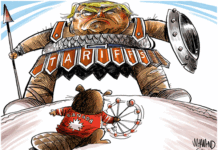
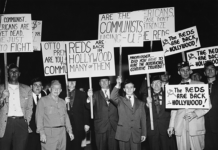
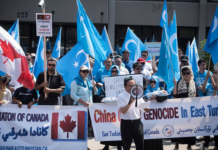




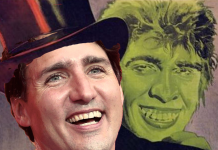
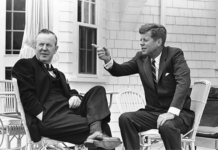

[…] was “the author whom I knew the best among all English writers before I went to college.” [10] As a British war correspondent, Henty’s travels across Europe, the Middle East, Africa and […]
[…] On the home front, Pearson’s fierce anticommunism justified Canada’s systematic abuses of civil rights. As Ian MacKay and Jamie Swift note in Warrior Nation: “Pearson enthusiastically supported a Cold War against any Canadians suspected of viewing the world outside the newly hegemonic framework of the American imperium.”[1] […]
re “Many Canadians believe the myth today that Pearson helped keep Canada out of the Vietnam War. However, 40,000 Canadians joined the U.S. armed forces during the war.”
It should be made clear that those Canadians did not fight as Canadian soldiers. Canada did not supply troops, but did supply military goods destined for US use in Vietnam.
re Mackenzie King not being “hawkish” unlike Pearson siding up to the USA: I wouldn’t exaggerate this point. Mackenzie King was initially enamoured by Hitler, and was an enthusiast for the British Empire. Much of the anti-American position in Canada was pro-British and pro-Empire (also the case with P.M. John Diefenbaker) — it wan’t Canadian independentist. King came around, obviously, and Canada contributed much to the war effort, including the development of the atom bomb, which also began under King’s watch.
However, missing in this piece also is the famous incident in 1965 when Pearson criticized the US for its Vietnam policy, and Johnson held up Pearson by his lapels and told him: ‘Don’t you come into my living room and piss on my rug.’ This was after Pearson tried to convince the US President to Pause for Peace and stop the bombing campaign in North Vietnam in an effort get the North to commence peace talks; a suggestion that had also been made to JFK during the missile crisis to encourage the Soviets to gracefully back down — and that seemed to work. The Cold War was, some seem to forget today, a very harsh polarizing moment. Stalin’s reign in the USSR was no utopian dream, and while there was media propaganda portraying that country in its worst light, there were truths about the portrayal as well. Most Canadians wanted nothing to do with Stalinist USSR or Maoist China — these realities should not be discounted when writing about the role of Pearson during this period. He had his faults, certainly.
I also wouldn’t make too much of William Stephenson being the model for the “anti-communist James Bond” 007, given he also played a primary role in encourageing Roosevelt to support the British against the Nazis (such as through lend-lease) until the US entered the war after Pearl Harbour. He also encouraged Churchill to oppose the appeasement policy of Chamberlain, having watched and warned about Hitler’s military buildup since the mid 1930s.
Robin, It was *illegal* for Cdns to join foreign militaries (and perhaps it still is). However, NOT EVEN ONE of the 40,000 Cdns who joined the US military during the Vietnam war was ever charged let alone prosecuted. Why? That represents significant Cdn support for this US war considering that 40,000 was 50% more than the number of Cdns that had fought in Korea, that other US-led war against communism that killed millions of people with the help of billions in Cdn war technologies!
You raise Johnson’s manhandling of Pearson as if this proves Pearson said something to oppose the Vietnam war. Lots of people labour under this delusion. Pearson was NOT against that war at all. He made Johnson angry because he dared suggest that the US have “PAUSES” in their incessant bombing of Vietnam. He did not want to END the bombing only PAUSE it. Why? Pearson made this strategic suggestion because he knew that such pauses would to give the much-hated enemy some time to reflect on what both Johnson and Pearson wanted them to do, ie., to decide to surrender to the US.
Bombing a country is like torturing an individual. Just as it is well known that the best way to torture individuals is to have rest periods between torture sessions, Pearson very smartly realized that the best way to win the Vietnam war was to have rest periods between the bombing sessions. Do this make Pearson a better person than Johnson? or just a smarter warrior who knew a better way to get the enemy to surrender? Once the Viet Cong surrendered the US and Cda could avail themselves of all the resources there, and destroy any chance of a good example being set for others who wanted to free themselves from the colonial grip of racist, European imperial domination and captivity.
Yes, I’ve documented King’s loving infatuation with Hitler. You say King “was *initially* enamoured by Hitler.” That “initial” period lasted right into 1939! It lasted through 6 years of Hitler suspending democracy, closing newspapers, and rounding up hundreds of thousands of innocent people and putting them into concentration camps. Why didn’t Canada’s most beloved Liberal leader know better than to support Hitler (and Mussolini)? Because Pearson shared Hitler’s hatred of Jews and communists and clearly said in his diaries that Hitler was a was the “deliverer” (ie saviour) of Europe.
Yes, of course Dief was a proBritish imperialist. He was also virulently anticommunist like Pearson.
However Dief stood up to the US on many foreign policy issues while Pearson went along with the US because, as he said repeatedly, the US was leading the world in the fight against Soviet communism and all of the communist-led, anticolonial movements throughout the Third World. (He didn’t point out though, as I like to do, that before the US came along to lead the world against communism, it was Nazi Germany that fulfilled that role. The US took that over from the Nazis.
Dief WAS indeed developing an independent foreign policy, in that it was independent of the US.
Here are some examples of Dief’s independence from the US. Some of these help to explain why JFK & the Dulles boys hated Dief so much & led the effort to oust him, as they did to others around the world who did similar things. Putting Pearson in power in ’63, the US was ensured of support for the many wars, invasions and coups that soon followed:
John Diefenbaker’s “Made in Canada” Policies
“Diefenbaker promoted Canadian independence with evangelical zeal… ‘We are a power, not a puppet,’ the Chief thundered during the controversy over the placement of U.S. nuclear warheads in Canada. ‘His rampant nationalism alienated the entire ruling class: Bay Street, Wall Street, his civil service and politicians from all parties. [George] Grant credited the Chief with the strongest stance against satellite status ever attempted by a Canadian. This stance came at a high price.”
Source: Laurence Martin, Pledge of Allegiance, The Americanization of Canada in the Mulroney Years, 1993.
Cuban Missile Crisis:
When U.S. spy planes showed missile sites being constructed in Cuba, Kennedy decided to blockade Russian ships en route to Cuba. Despite NORAD, the Canada-U.S. Permanent Joint Board on Defense and NATO, Kennedy neither consulted nor informed the Canadian government until [two hours] before his TV speech on Oct. 22, 1962.
The U.S. asked the Canadian government to move our military to an advanced state of readiness. Diefenbaker did not comply. Nonetheless, Canada’s military moved immediately to advanced readiness without the Prime Minister’s authorization. Canada’s chief of naval staff ordered the Atlantic fleet to sea. Canada’s Minister of Defense ordered the military’s Chiefs of Staff to special preparedness.
General McNaughton’s 1941 remark is painfully relevant: “The acid test of sovereignty is control of the armed forces.”1 Howard Green, Canada’s anti-nuclear External Affairs minister, pleaded that cabinet reconsider “blindly following the U.S. lead, particularly since the President had not kept the commitment to consult Canada over the impending [missile] crisis.
‘If we go along with the U.S. now, we’ll be their vassal forever.'”2
Footnotes:
1. C.P. Stacey, Canada and the Age of Conflict, Vol.2, p.349.
2. Peter Newman, Renegade in Power: The Diefenbaker Years, p.337, p.337.
Source: Robin Mathews, Canadian Foundations web site http://www.ola.bc.ca/online/cf/module-4/usrel.html
The Avro and the Bomarcs:
Diefenbaker cancelled the Avro Arrow fighter plane program (1959) because the U.S. wouldn’t buy any of them. Although then expected to arm Canada’s Bomarc missiles with U.S. nuclear warheads, Diefenbaker refused.
Operation Sky Hawk:
Dief cancelled a U.S. nuclear war-related training exercise over Canada (1959).
Cuba:
Diefenbaker refused U.S. demands to stop trading with Cuba, and instead increased Canada’s trade (1960).
Apartheid:
At a Commonwealth conference (1961), Diefenbaker was the only white leader to support the African and Asian members against allowing South African membership.
Immigration:
After Diefenbaker’s Bill of Rights (1960), the government reduced immigration restrictions based on racial grounds and began to accept more Asian and black immigrants.
Women:
Dief appointed the first women cabinet minister and senator.
First Nations:
Native people allowed to vote for the first time (1960).
OAS:
Dief resented JFK’s speech to Parliament urging Canada to join the Organization of American States, because Dief had already refused (1961).
China:
Diefenbaker refused U.S. requests to cut off wheat supplies to China if they continued supporting Vietnamese independence efforts (1962).
Nuclear Test Ban:
Kennedy pushed for opposition to the treaty, but Canada voted for it (1962). The U.S. and most NATO countries abstained.
Sources: Knowlton Nash, Kennedy and Diefenbaker, 1990 and http://www.canschool.org/relation/history/7turbu-e.asp
I have argued elsewhere that a better understanding of Canadian “mixed” behaviour in terms of nuclear weapons policy, foreign policy, and positioning with respect to the US is found in institutional allegiance to multilateralism and loyalty to allies. When finding Mackenzie King, Pearson or Diefenbaker or Pierre Trudeau or others “mostly good” versus others being “mostly bad”, it is often because of expactations based in simple belief systems. Erika Simpson’s book NATO and the Bomb describes this phenomenon well, as did Joseph Levitt — the contradictions of Canadian foreign policy. If we want to “prove” a case one way or the other, it is easy to cherry pick examples (illegal for Canadian soldiers to fight in the militaries of others, so why weren’t they arrested when they came home… just for example). A more balanced approach is to look at Canadian Prime Ministers as flawed individuals bound to disappoint, but working within the limiltations of their times and political parties, not to mention unforgiving electorates. I think there are many good things Pearson and Dief and Trudeau did; and many bad things. My problem with your series is that you seemed to find nothing good in what Pearson did. Given you must have scanned through several biographies, that means you must have ignored the good he did because you were only looking for the bad he did.
A good example of cherry picking: “You say King “was *initially* enamoured by Hitler.” That “initial” period lasted right into 1939! It lasted through 6 years of Hitler suspending democracy, closing newspapers, and rounding up hundreds of thousands of innocent people and putting them into concentration camps. Why didn’t Canada’s most beloved Liberal leader know better than to support Hitler (and Mussolini)? Because Pearson shared Hitler’s hatred of Jews and communists and clearly said in his diaries that Hitler was a was the “deliverer” (ie saviour) of Europe.” My comment of course was not a defence of King for supporting Mussolini and Hitler, but a reminder that he changed his tune and Canada because a warrior against fascism. Antisemitism was common in the day (and many allied leaders had some prejudice in that area — although Churchill far less so than average). in a 2008 article, “By 1939, the outbreak of the war, Pearson had gone well beyond appeasement and isolationism, suggesting that Nazism represented a descent into ‘savagery and barbarism’. Once war on the European continent erupted and Canada was militarily involved in it, Pearson was a hawk, urging the Canadian prime minister to commit all resources to it.” But, Richard, you write as if Pearson was a resolute Hitler supporter and virulent anti-semite. This is going way too far.
After 1939 when King’s mad love for Hitler finally waned, you say that: “he changed his tune and Canada because [sic] a warrior against fascism. Antisemitism was common in the day (and many allied leaders had some prejudice in that area…”
If he really “changed his tune” and became an antifascist why did Canada under his leadership continue to bar Jews and communists from fleeing to Canada during and after the war (just as they had done before the war)? If he really “changed his tune,” why did Canada put Jewish and communist refugees in POW camps thoughout most of the war?! And, if King really “changed his tune,” why did Canada (while barring Jews and Communists from fleeing to Canada) go out of its way to allow so many thousands of Waffen SS veterans into Canada after the war?
Have you read my article in on King in Defunding the Myths and Cults of Cold War Canada? It’s called: “Mackenzie King: A simpleton who naively praised Hitler until 1939”
https://coat.ncf.ca/P4C/70/70_14-16.htm
There are three sidebars to this article:
“Liberal immigration: ‘None is too many’ but Too many is not enough”
https://coat.ncf.ca/P4C/70/70_14.htm
“King loved Hitler’s hate speech (Feb. 20, 1938) against ‘Jewish international Bolshevism'”
https://coat.ncf.ca/P4C/70/70_16.htm
“King supported Adolph Hitler
throughout the 1930s. Why didn’t he know better?”
https://coat.ncf.ca/P4C/70/70_15.htm
Richard, as there was no “reply” link to your reply below, I’ll answer here.
Re: King’s Change of Tune
You wrote: “If he really “changed his tune” and became an antifascist why did Canada under his leadership continue to bar Jews and communists from fleeing to Canada during and after the war (just as they had done before the war)? If he really “changed his tune,” why did Canada put Jewish and communist refugees in POW camps thoughout most of the war?! And, if King really “changed his tune,” why did Canada (while barring Jews and Communists from fleeing to Canada) go out of its way to allow so many thousands of Waffen SS veterans into Canada after the war?”
This is another pretty good example of your approach of “either X is all good or all bad”.
I did not argue that Mackenzie King became a communist party supporter. I said he “changed his tune” with regards to Hitler. And he did. Canada, under King, played a significant role in WW2 in opposing and defeating Hitler.
You went on to offer examples of King not taking on a list of good causes. King was not my favourite prime minister, although he did some good things on the labour and welfare front — better than some others. I also didn’t suggest King eschewed his antisemitism for all time. The None is Too Many incident is very well known, for example. I simply noted that King figured out that Hitler was not good for Europe, and Britain in particular.
As to why King put communists etc into POW camps during WW2? Initially it was because the communist party supported the Stalin-Hitler pact, for one thing. “The [Canadian] Communist Party was banned in 1941 under the Defence of Canada Regulations and [leader Tim] Buck and other prominent Communist leaders were forced underground and ultimately into exile in the United States because of their support for the pact between Hitler and the USSR”.* Later the CP was legalized under a different name, as you no should know. But beyond that King was an anti-communist. He saw communists as secretly working for the USSR against Canada. That was a common belief at the time.
King also jailed Japanese- and German- and Italian-Canadians because of their presumed disloyalty, a terrible racist reaction. “Like supporters and immigrants from Axis countries, communists were considered in collusion with Hitler and all suspected of strongly supporting this alliance were interned under the War Measures Act.”*
I am hoping you don’t think that there were only two choices: Hitler or Stalin. MOST Canadians at the time could be said to oppose both those options, and that was the position of Mackenzie King too. But the point I made was that he changed his view of Hitler, mostly. He was willing to engage in the alliance with Stalin. Briefly.
*Thanks to wikipedia for doing the work for me on this.
[…] On the home front, Pearson’s fierce anticommunism justified Canada’s systematic abuses of civil rights. As Ian MacKay and Jamie Swift note in Warrior Nation: “Pearson enthusiastically supported a Cold War against any Canadians suspected of viewing the world outside the newly hegemonic framework of the American imperium.”[1] […]
EXCELLENT ARTICLE!
[…] By Richard Sanders (originally published on Covert Action Magazine) […]